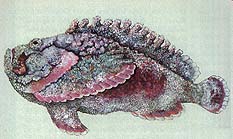 The chances of being stung by a stonefish, probably the most dangerous fish in Arabian waters (sharks included) are fortunately not great enough to justify staying out of the sea. The main problem is that recognising a stonefish, even if it is right in front of your eyes, is very difficult. Their camouflage is incredibly effective and only experienced fish-watchers who have a trained eye are likely to see them. Given this natural disadvantage there are several things that you can do to reduce the likelihood of standing on, sitting on, or accidentally touching one of these highly poisonous fish.
The chances of being stung by a stonefish, probably the most dangerous fish in Arabian waters (sharks included) are fortunately not great enough to justify staying out of the sea. The main problem is that recognising a stonefish, even if it is right in front of your eyes, is very difficult. Their camouflage is incredibly effective and only experienced fish-watchers who have a trained eye are likely to see them. Given this natural disadvantage there are several things that you can do to reduce the likelihood of standing on, sitting on, or accidentally touching one of these highly poisonous fish. First of all it helps to recognise where the danger is most likely to lie. Stonefish prefer shallow water (from just below the surface to around 3 metres) although they can be found at much greater depths. They are often found clinging to algal covered rocks in the surge-zone, where constant wave action makes it difficult to stay still, but where the stonefish anchors itself quite effectively to the substrate, merging perfectly with the background. The greatest danger of being stung is when wading through the shallows, across the reef-top, and especially near the reef-edge. One should always wear thick soled plastic sandals or reef-walking shoes if one is treading on the bottom and whenever possible one should swim, rather than walk, thus reducing damage to the marinelife and lessening the danger of being stung by a stonefish. When walking it is a good idea to shuffle one foot in front of the other rather than to take big strides in which each foot is raised up and then placed down onto the seabed with the risk of landing on a stonefish. The shuffle motion will increase the likelihood that you scare a stonefish away from your tracks rather than precipitate its ire by descending from on high onto its potentially lethal spines.
In the event that you are stung by a stonefish do not panic. Although the pain will be excruciating stonefish stings are generally not fatal and there is a great deal that can be done to lessen the effects of the poison and to accelerate recovery. The stonefish is armed with thirteen strong spines along its back. When the stonefish is trodden on, or otherwise angered, the spines lock into an erect position and poison is injected into the foot or other offending body-part. The poison itself is an unstable, high molecular weight, protein that has an effect upon muscles including respiratory and heart muscle. Early symptoms after a poisoning include shock, depressed breathing, local paralysis and agonising pain.
The first thing to do is to find a nearby source of hot, hot water. Clean the wound, removing any debris, and place the foot, hand or other wounded section of the body into the hot water (NOT boiling but as hot as the patient can stand without being physically scalded). In the laboratory the poison is denatured by exposure to 50°C temperatures for just two minutes but since the poison is already injected into the body it will be impossible to achieve such a rapid effect. For this reason the heat treatment should be continued for at least an hour and possibly an hour and a half or more. The sooner this is done the more effective it will be.
The patient should be made to lie down and the injured foot (or other body-part) should be elevated above the rest of the body. In the most likely event that it is the sole of a foot that is stung, the leg should be propped up and the knee bent so that the foot is immersed in a bowl of hot water which is supported at a level above that of the bed, ground or bench upon which the victim is lying. If potassium permanganate is available, a weak 5% solution of this can be used to wash out the wound.
Once the first-aid stage is completed, or if full medical facilities are close by, take the patient to a place where stonefish antivenin can be administered. Further details on this valuable medicine are available in the book, Red Sea Safety (Immel Publishing, ISBN 1 898 162 700).
Although stonefish are quite common in shallow waters around Arabia's extensive coastline, the occurrence of accidents involving stingings is quite rare. Providing one takes sensible precautions there should be nothing to worry about.
No comments:
Post a Comment